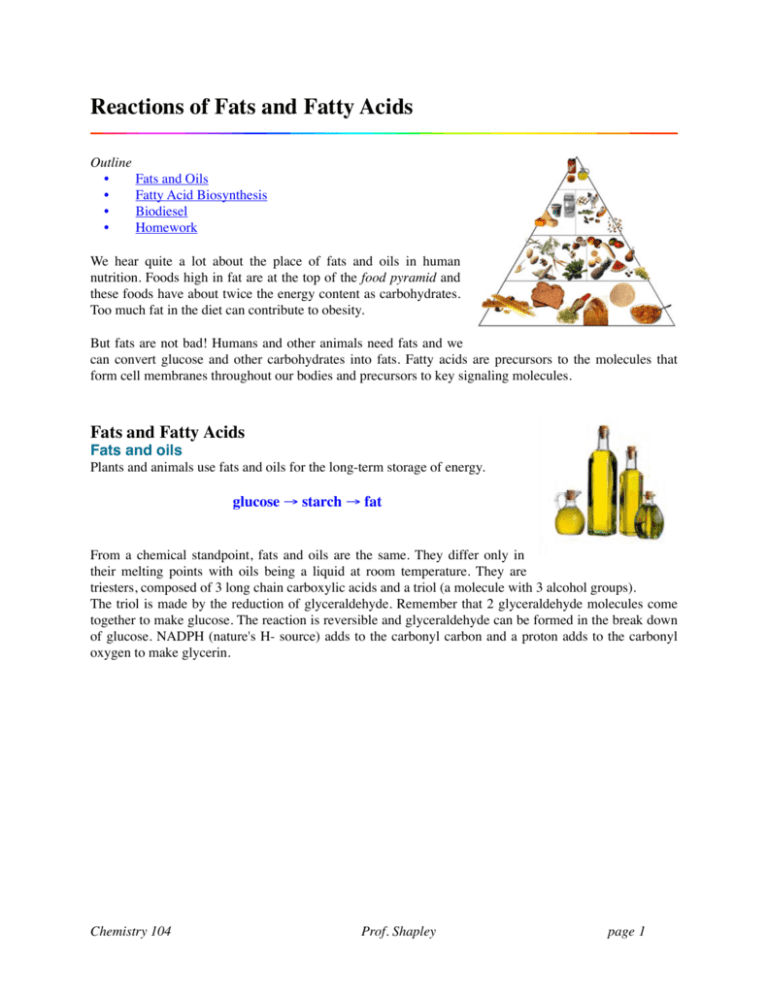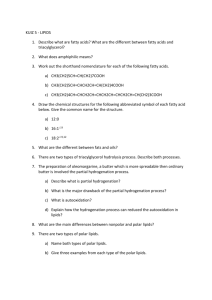Reactions of Fats and Fatty Acids
advertisement

Reactions of Fats and Fatty Acids Outline • Fats and Oils • Fatty Acid Biosynthesis • Biodiesel • Homework We hear quite a lot about the place of fats and oils in human nutrition. Foods high in fat are at the top of the food pyramid and these foods have about twice the energy content as carbohydrates. Too much fat in the diet can contribute to obesity. But fats are not bad! Humans and other animals need fats and we can convert glucose and other carbohydrates into fats. Fatty acids are precursors to the molecules that form cell membranes throughout our bodies and precursors to key signaling molecules. Fats and Fatty Acids Fats and oils Plants and animals use fats and oils for the long-term storage of energy. glucose → starch → fat From a chemical standpoint, fats and oils are the same. They differ only in their melting points with oils being a liquid at room temperature. They are triesters, composed of 3 long chain carboxylic acids and a triol (a molecule with 3 alcohol groups). The triol is made by the reduction of glyceraldehyde. Remember that 2 glyceraldehyde molecules come together to make glucose. The reaction is reversible and glyceraldehyde can be formed in the break down of glucose. NADPH (nature's H- source) adds to the carbonyl carbon and a proton adds to the carbonyl oxygen to make glycerin. Chemistry 104 Prof. Shapley page 1 Each of the alcohol groups on glycerin can act as a nucleophile towards a carboxylic acid. Chemistry 104 Prof. Shapley page 2 Fatty acids Some of the common fatty acids are listed in the table below. Some of these have alkyl chains that are completely saturated (no double bonds). Steric acid, for example, is a major component of animal fat. Unsaturated fats have C-C double bonds in their fatty acids. Oleic acid is one of the components of olive oil. The presence of double bonds changes the shape of the fatty acid. All natural fatty acids with C-C double bonds are in the "cis" configuration. Partial hydrogenation of unsaturated fats forms "trans fats" that can cause health problems. Palmitoleic acid Sapienic acid Oleic acid Linoleic acid alpha-Linolenic acid Arachidonic acid Lauric acid CH3(CH2)5CH=CH(CH2)7COOH CH3(CH2)8CH=CH(CH2)4COOH CH3(CH2)7CH=CH(CH2)7COOH CH3(CH2)4CH=CHCH2CH=CH(CH2)7COOH CH3CH2CH=CHCH2CH=CHCH2CH=CH(CH2)7COOH CH3(CH2)4CH=CHCH2CH=CHCH2CH=CHCH2CH=CH(CH2)3COOH CH3(CH2)10COOH Chemistry 104 Prof. Shapley page 3 Myristic acid Palmitic acid Stearic acid CH3(CH2)12COOH CH3(CH2)14COOH CH3(CH2)16COOH Fatty acid derived natural products Substitution of one of the fatty acids of fats gives phospholipids. These form the lipid bilayers of cell membranes. The polar phosphate part of the molecule interacts strongly with water at the outside of the membrane while the long alkyl chains are hydrophobic and remain on the inside. Fats are also converted into: • waxes, protective coatings • prostaglandins, immunosuppressants • terpenes, essential oils • steroids, including cholesterol, cortisone, sex hormones, and bile acids Biosynthesis of Fat Chemistry 104 Prof. Shapley page 4 Glucose metabolism Glucose is both stored energy for living things and the precursor to other biomolecules. Respiration is an enzyme catalyzed process that releases energy to the cells. From an energy standpoint, it is identical to the combustion reaction of glucose and it releases 6 equivalents of carbon dioxide and 6 equivalents of water for every equivalent of glucose. In biosynthetic reactions, the glucose is broken down into 2, three-carbon pieces. One equivalent of carbon dioxide is lost for every one of the 3carbon units. Four carbons of the original sixcarbon glucose molecule are used in the synthesis of fatty acids. It's a complicated process and we won't go over the whole thing in detail but let's look at the first step. That is the base-catalyzed isomerization of glucose to fructose. As you can see, the first step is a base (basic site in a protein) removes a proton from C2 of the glucose molecule. The pair of electrons from the former C-H bond migrate to form a C-C pi bond and another pair of electrons (from the C=O group) migrates to the carbonyl oxygen. The oxygen anion is basic and abstracts a proton from water. As a new C-O double bond forms on C2, the proton from the C2 hydroxy group migrates to C1. Chemistry 104 Prof. Shapley page 5 Carbon Acids All the acids we've talked about so far have had an acidic hydrogen attached to either an oxygen or nitrogen atom. The electronegative oxygen or nitrogen atoms can stabilize the negative charge in the conjugate base. In the isomerization of glucose, a C-H unit provides the acidic hydrogen. How can this happen? Electron-withdrawing groups adjacent to the carbon make that carbon very electron-poor and allow it to stabilize the conjugate base. Stabilizing the conjugate base makes the acid stronger. A typical saturated alkane, such as ethane, is not at all basic. It has a pKa of about 48. Remember that the higher the pKa, the weaker is the acid. The strong mineral acids have negative pKa values. The adjacent carbonyl group makes a ketone, aldehyde, or carbonyl acid ester a stronger acid than an alkane. The pKa of propanone is 25, still a weak acid but much stronger than an alkane. We can draw two equivalent Lewis structures for the conjugate base: one with the negative charge on carbon and the other with the negative charge on the carbonyl oxygen. We can think of the extra electron density delocalized (and stabilized) over these two sites. When there is another electron-withdrawing group, an alcohol group or another carbonyl group, attached to the acidic C-H it becomes even more acidic. The pKa of the diketone is 11. This is a value much lower (more acidic) than water or a simple alcohol of 15-17. Chemistry 104 Prof. Shapley page 6 Fructose to Glyceraldehyde An enzyme catalyzes the conversion of fructose to 2 equivalents of glyceraldehyde. Glyceraldehyde is then oxidized (by NADP+) and converted to CH3C(O)C(O)OH. Coenzyme-A reacts with this to give an equivalent of carbon dioxide and a 2-carbon fragment attached to the protein. Carbon-Carbon Bond Formation The protein bonded CH3C(O)- fragments react together in a stepwise fashion. At each step, NADPH and protons are needed to reduce one of the carbon centers. Because fatty acids are formed from these C2 units, all fatty acids have an even number of carbon atoms. Biodiesel Diesel from crude oil (petrodiesel) is a mixture of saturated hydrocarbons and some aromatic hydrocarbons with an average composition from C10H22 to C15H32. Biodiesel fuel can be produced from a variety of agricultural sources. Any plant oil can be modified to fatty acid esters. Because of the oxygen content, these burn with less soot than diesel from crude oil. Biodiesel can also be converted to gasoline through catalytic cracking and reforming. Chemistry 104 Prof. Shapley page 7 As you know, fats and oils are made by plants and animals for the long term storage of energy. These are triesters of glycerol, a triol. Because they have long chain alkane and alkene units, they contain more chemical energy than sugars and starches. You can use the approximate bond energies to calculate the energy released by the combustion of the oil above to CO2 and water vs. 9.5 equivalents of glucose. The oil itself is not biodiesel. It must be converted to fatty acid methyl esters (FAMEs) by transesterification. What is the mechanism of the transesterification process? The key is the chemistry of the ester functional group. The carbon carbonyl is bonded to 2 electronegative oxygen atoms, making it electron poor and so an electrophilic center. The oxygen if methanol has 2 lone pairs of electrons, making it a nucleophile. Before nucleophilic substitution can take place, the alkoxide oxygen on the ester must be protonated to make it a better leaving group. Like all reactions of carboxylic acid derivatives, the substitution of one group by another at the carbonyl carbon goes through a 4-coordinate intermediate. Chemistry 104 Prof. Shapley page 8 Many of the plant oils have sites of unsaturation in the side chains of the esters. These C=C functional groups can be oxidized under atmospheric conditions. (We'll discuss the mechanism later.) Oxidation causes the chains to break at these points and release volatile, short-chain carboxylic acids, aldehydes, and alcohols. In other words, the oil becomes rancid. The oxidative instability of the FAMEs from plant sources is a major problem with biodiesel. In the US, soy is an important source of biodiesel but rapeseed is the primary source in Germany. Palm oil is a better source than soy for diesel but it requires people rather than machines to harvest it. Typical oil extraction Oil Seed Cotton Seed Soy bean Mustard Sesame Sunflower Rapeseed Castor Seed Palm Oil from 100 kg 13 kg 14 kg 35 kg 50 kg 32 kg 37 kg 50 kg 56 kg Chemistry 104 Gal/acre 35 48 51 74 102 127 151 635 Prof. Shapley page 9








